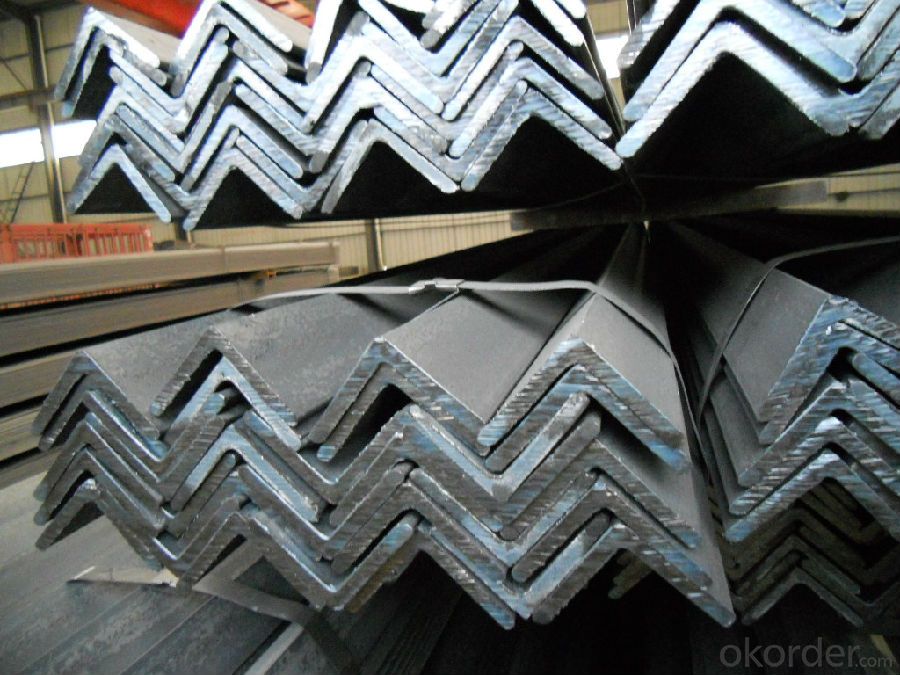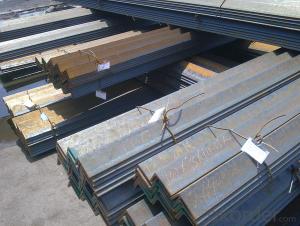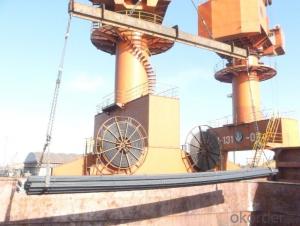Hot Rolled Steel High Qulity Angle Steel Unequal Steel Angle Made In China
- Loading Port:
- Tianjin
- Payment Terms:
- TT OR LC
- Min Order Qty:
- 50 m.t.
- Supply Capability:
- 30000 m.t./month
OKorder Service Pledge
OKorder Financial Service
You Might Also Like
Specification
Product Description:
OKorder is offering Hot Rolled Steel High Qulity Angle Steel Unequal Steel Angle Made In China at great prices with worldwide shipping. Our supplier is a world-class manufacturer of steel, with our products utilized the world over. OKorder annually supplies products to European, North American and Asian markets. We provide quotations within 24 hours of receiving an inquiry and guarantee competitive prices.
Product Applications:
Hot Rolled Steel High Qulity Angle Steel Unequal Steel Angle Made In China are ideal for structural applications and are widely used in the construction of buildings and bridges, and the manufacturing, petrochemical, and transportation industries.
Product Advantages:
OKorder's Hot Rolled Steel High Qulity Angle Steel Unequal Steel Angle Made In China are durable, strong, and resist corrosion.
Main Product Features:
· Premium quality
· Prompt delivery & seaworthy packing (30 days after receiving deposit)
· Corrosion resistance
· Can be recycled and reused
· Mill test certification
· Professional Service
· Competitive pricing
Product Specifications:
Sizes: 25mm-250mm | ||
a*t | ||
25*2.5-4.0 | 70*6.0-9.0 | 130*9.0-15 |
30*2.5-6.6 | 75*6.0-9.0 | 140*10-14 |
36*3.0-5.0 | 80*5.0-10 | 150*10-20 |
38*2.3-6.0 | 90*7.0-10 | 160*10-16 |
40*3.0-5.0 | 100*6.0-12 | 175*12-15 |
45*4.0-6.0 | 110*8.0-10 | 180*12-18 |
50*4.0-6.0 | 120*6.0-15 | 200*14-25 |
60*4.0-8.0 | 125*8.0-14 | 250*25 |
Usage & Applications of Angle Steel
According to the needs of different structures, Angle can compose to different force support component, and also can be the connections between components. It is widely used in various building structures and engineering structures such as roof beams, bridges, transmission towers, hoisting machinery and transport machinery, ships, industrial furnaces, reaction tower, container frame and warehouse etc.
Packaging & Delivery of Angle Steel
1. Packing: it is nude packed in bundles by steel wire rod
2. Bundle weight: not more than 3.5MT for bulk vessel; less than 3 MT for container load
3. Marks:
Color marking: There will be color marking on both end of the bundle for the cargo delivered by bulk vessel. That makes it easily to distinguish at the destination port.
Tag mark: there will be tag mark tied up on the bundles. The information usually including supplier logo and name, product name, made in China, shipping marks and other information request by the customer.
If loading by container the marking is not needed, but we will prepare it as customer request.
Production flow of Angle Steel
Material prepare (billet) —heat up—rough rolling—precision rolling—cooling—packing—storage and transportation
FAQ:
Q1: Why buy Materials & Equipment from OKorder.com?
A1: All products offered byOKorder.com are carefully selected from China's most reliable manufacturing enterprises. Through its ISO certifications, OKorder.com adheres to the highest standards and a commitment to supply chain safety and customer satisfaction.
Q2: How do we guarantee the quality of our products?
A2: We have established an advanced quality management system which conducts strict quality tests at every step, from raw materials to the final product. At the same time, we provide extensive follow-up service assurances as required.
Q3: How soon can we receive the product after purchase?
A3: Within three days of placing an order, we will begin production. The specific shipping date is dependent upon international and government factors, but is typically 7 to 10 workdays.
Q4: What makes stainless steel stainless?
A4: Stainless steel must contain at least 10.5 % chromium. It is this element that reacts with the oxygen in the air to form a complex chrome-oxide surface layer that is invisible but strong enough to prevent further oxygen from "staining" (rusting) the surface. Higher levels of chromium and the addition of other alloying elements such as nickel and molybdenum enhance this surface layer and improve the corrosion resistance of the stainless material.
Q5: Can stainless steel rust?
A5: Stainless does not "rust" as you think of regular steel rusting with a red oxide on the surface that flakes off. If you see red rust it is probably due to some iron particles that have contaminated the surface of the stainless steel and it is these iron particles that are rusting. Look at the source of the rusting and see if you can remove it from the surface.
Images:



- Q: Can steel angles be used in the construction of government buildings?
- Yes, steel angles can be used in the construction of government buildings. Steel angles are commonly used in construction due to their strength, durability, and versatility. They are often used for structural support, framing, and reinforcement in various building projects, including government buildings.
- Q: Can steel angles be used in sports facilities or stadium constructions?
- Yes, steel angles can be used in sports facilities or stadium constructions. Steel angles are commonly used in the construction industry due to their versatility, strength, and durability. In sports facilities or stadium constructions, steel angles can be used for various purposes. One of the key applications of steel angles in sports facilities and stadium constructions is in the framework and support structures. Steel angles can be used to create the framework for seating areas, walkways, stairs, and entrances. They provide excellent structural support and can withstand heavy loads, making them ideal for accommodating large crowds and ensuring the safety of the spectators. Steel angles can also be used in the construction of various sports equipment. For instance, they can be used to create the framework for basketball hoops, soccer goals, or volleyball nets, ensuring stability and durability during intense gameplay. Additionally, steel angles can be utilized for the construction of fencing or barriers around sports fields or tracks, providing safety and security for both players and spectators. Furthermore, steel angles are often used in the installation of lighting systems in sports facilities and stadiums. They can be used to mount floodlights, scoreboards, or other equipment necessary for proper illumination during games or events. In summary, steel angles are an essential component in sports facility and stadium constructions. Their strength, versatility, and durability make them a reliable choice for various applications, including framework and support structures, sports equipment, and lighting systems.
- Q: Can steel angles be used for transmission towers?
- Indeed, transmission towers can utilize steel angles. Within the construction sector, steel angles are frequently employed for a range of structural purposes, including transmission towers. Their exceptional strength and stability make them well-suited for bearing substantial loads and enduring the harsh elements of outdoor settings. The fabrication, welding, and bolting processes for steel angles are straightforward, allowing for the creation of the necessary shapes and arrangements for transmission towers. Moreover, they boast commendable corrosion resistance, a vital feature for structures exposed to varying weather conditions. All in all, steel angles represent a prevalent and dependable option for constructing transmission towers.
- Q: Can steel angles be used for manufacturing outdoor benches?
- Outdoor benches can indeed be manufactured using steel angles. These angles possess remarkable strength and durability, rendering them highly suitable for outdoor settings where benches may face harsh weather conditions. Moreover, it is effortless to weld steel angles together, allowing for the creation of a robust frame for the bench. This steel frame can then be combined with alternative materials like wood or metal slats to fashion the seating surface. In summary, steel angles are widely favored when it comes to manufacturing outdoor benches due to their exceptional strength, durability, and versatility.
- Q: What are the common connection methods for steel angles?
- The common connection methods for steel angles include bolting, welding, and using mechanical fasteners such as screws or rivets. These methods ensure a secure and stable connection between steel angles, allowing them to be used effectively in various structural applications.
- Q: What are the common methods of surface preparation for steel angles?
- Steel angles can be prepared for surface treatment through various methods, including grinding, sandblasting, and chemical cleaning. Grinding is a mechanical technique that involves using an abrasive wheel or disc to smooth and level the surface of the steel angle. This method effectively eliminates rust, scale, and other imperfections. It is commonly used for small-scale projects or when achieving a smooth surface finish is not crucial. Sandblasting, also referred to as abrasive blasting, entails propelling small particles onto the surface of the steel angle at high speeds. This method is highly efficient in removing mill scale, rust, paint, and other contaminants. Sandblasting creates a textured surface that enhances the adhesion of coatings or paints. It is often employed in large-scale industrial projects that require a high-quality surface finish. Chemical cleaning involves the use of chemical solutions to eliminate contaminants from the surface of the steel angle. This method effectively removes rust, oil, grease, and other organic materials. Chemical cleaning can be carried out using various techniques, such as immersion or brush application. It is typically employed when sandblasting or grinding is not feasible or practical. Additionally, power tool cleaning, flame cleaning, or a combination of methods may be used for surface preparation, depending on the specific project requirements. It is crucial to select the appropriate method based on the condition of the steel angle, the desired surface finish, and the intended application of the steel angle.
- Q: Can steel angles be used in modular building systems?
- Yes, steel angles can be used in modular building systems. Steel angles provide structural support and can be easily integrated into the modular construction process. They offer strength, durability, and flexibility, making them suitable for various applications in modular building systems.
- Q: What are the different types of steel angles used in architectural façade systems?
- There are several different types of steel angles that are commonly used in architectural façade systems. These angles serve various purposes and are chosen based on the specific requirements of the project. 1) L-Angles: L-angles are one of the most commonly used types of steel angles in façade systems. They have a 90-degree angle and are often used to create the framework for curtain wall systems. L-angles provide structural support and stability to the façade while also allowing for the attachment of various cladding materials. 2) Z-Angles: Z-angles, also known as Z-bars, are another type of steel angle used in façade systems. They have a Z-shaped profile, with two flanges that are parallel to each other. Z-angles are often used to create horizontal or vertical support members in curtain wall systems, providing additional strength and rigidity. 3) C-Angles: C-angles, also called C-channels or C-beams, are widely used in façade systems for their versatility and strength. They have a C-shaped profile, with a wide base and two flanges that are perpendicular to each other. C-angles are commonly used as support members for cladding panels or as framing elements for architectural features like canopies or sunshades. 4) T-Angles: T-angles, also known as T-bars, have a T-shaped profile and are used in façade systems for various purposes. They can be used as support members for cladding panels, providing a stable base for attachment. T-angles are also used to create mullions or transoms in curtain wall systems, allowing for the integration of windows or glazing units. 5) Unequal Angles: Unequal angles, as the name suggests, have unequal leg lengths. They are used in façade systems when there is a need for uneven or specialized support. Unequal angles are often used to create custom shapes or profiles, allowing architects and designers to achieve unique aesthetic effects or accommodate specific project requirements. Each type of steel angle has its own advantages and applications in architectural façade systems. The choice of angle will depend on factors such as structural requirements, design considerations, and the specific needs of the project.
- Q: Can steel angles be used in historical or heritage restoration projects?
- Yes, steel angles can be used in historical or heritage restoration projects. Steel angles are versatile and can be used in a variety of applications, including structural support, reinforcing, and decorative detailing. They can be fabricated to match the original design and materials used in historical structures, ensuring a seamless integration with the existing architecture. Steel angles offer several advantages, such as strength, durability, and resistance to corrosion, which can be particularly beneficial in restoration projects where the goal is to preserve the historical integrity of the structure while improving its structural stability and longevity. Additionally, steel angles can be customized and fabricated to meet specific project requirements, making them suitable for a wide range of restoration applications.
- Q: Can steel angles be used in the construction of storage tanks?
- Yes, steel angles can be used in the construction of storage tanks. Steel angles provide structural support and enhance the overall integrity of the tank. They are commonly used for the construction of tank roofs, tank bottoms, and tank supports. Their strength and durability make them suitable for withstanding the pressure and weight of the tank's contents.
Send your message to us
Hot Rolled Steel High Qulity Angle Steel Unequal Steel Angle Made In China
- Loading Port:
- Tianjin
- Payment Terms:
- TT OR LC
- Min Order Qty:
- 50 m.t.
- Supply Capability:
- 30000 m.t./month
OKorder Service Pledge
OKorder Financial Service
Similar products
Hot products
Hot Searches
Related keywords




























